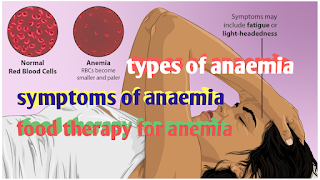Types of anaemia and its food therapy
Symptoms of anaemia
My dear friends The symptoms of anaemia can vary depending on the type and cause. However, some common signs and symptoms of anaemia include----
1. Fatigue and weakness
2. Pale or yellowish skin
3. Dizziness or lightheadedness
4. Shortness of breath or increased effort required for physical activities
5. Headaches
6. Rapid or irregular heartbeat (palpitations)
7. Cold hands and feet
8. Brittle nails
9. Glossitis (inflammation of the tongue)
10. Koilonychia (concave, spoon-shaped nails)
11. Cheilitis (inflammation of the lips)
12. Cravings for strange substances, such as dirt or ice (pica), which can occur in iron-deficiency anaemia.
Types of anaemia
There are several types of anemia, which can arise from various conditions and factors. Here are some of the most common types---
1. Iron-deficiency anemia
This is the most common type of anemia worldwide. It occurs when there isn't enough iron in your body to produce enough hemoglobin, which is necessary for red blood cells to transport oxygen.
2. Vitamin-deficiency anemia
A deficiency of certain vitamins, such as B12, folic acid, or vitamin C, can lead to anemia. These vitamins play a crucial role in the production of red blood cells and hemoglobin.
3. Hemolytic anemia
This occurs when your body destroys red blood cells faster than it can produce new ones. Causes can include inherited conditions, immune system disorders, or certain medications.
4. Aplastic anemia
This type of anemia occurs when your body doesn't produce enough red blood cells due to damage to your bone marrow, which is responsible for producing blood cells.
5. Sickle cell anemia
It's an inherited condition in which red blood cells are misshapen and break down more quickly than normal. This leads to a shortage of red blood cells and decreased oxygen-carrying capacity.
6. Thalassemia
It's a group of inherited disorders that affect hemoglobin production. People with thalassemia have abnormal or reduced amounts of hemoglobin, leading to anemia.
7. Megaloblastic anemia
It occurs when there's a deficiency of either vitamin B12 or folic acid, which causes the red blood cells to be larger and less efficient at transporting oxygen.
8. Anemia of chronic disease
This type of anemia is associated with chronic conditions, such as kidney disease, cancer, or autoimmune disorders, and can develop as the body's response to inflammation or reduced blood supply.
It's essential to consult with a healthcare professional to determine the cause of your anemia and discuss appropriate treatment options.
Food therapy for anemia
Food therapy can be a helpful approach to managing anemia, as it can help provide the essential nutrients needed to promote the production of red blood cells and improve overall health. Here are some food groups and specific foods that can help in managing anemia---
1. Leafy Green Vegetables
These are rich in iron, vitamin C, and folic acid, all of which are essential for producing healthy red blood cells. Consuming foods like spinach, kale, and collard greens can help combat anemia effectively.
2. Red Meat and Poultry
Foods like beef, lamb, and liver are excellent sources of iron and heme, which is easier for the body to absorb as compared to non-heme iron found in plant sources. You can also include chicken, duck, and turkey in your diet to increase iron levels.
3. Seafood
Fatty fish like salmon, mackerel, and sardines are rich in vitamin C and omega-3 fatty acids that promote iron absorption and help combat anemia.
4. Legumes
Lentils, beans, and chickpeas are good vegetarian sources of iron. Including these in your diet will help improve iron levels in the body.
5. Nuts and Seeds
Nutritional yeast, pumpkin seeds, and sunflower seeds are rich sources of iron, vitamin C, and zinc, which can all help combat anemia.
6. Whole Grains
Whole grain foods like brown rice, whole-wheat bread, and quinoa are good sources of iron, fiber, and B-vitamins that can help improve anemia.
7. Vitamin C-rich Foods
Citrus fruits like oranges, strawberries, and kiwi fruit can help improve iron absorption and reduce the risk of anemia.
8. Dairy Products
Foods like cheese and yogurt can help improve calcium levels in the body, which can indirectly help in managing anemia.
9. Eggs
Egg yolks are rich sources of iron, vitamin D, and other essential nutrients that can help improve anemia symptoms.
To make the most of food therapy for anemia, it is essential to include these food groups in a balanced diet and make sure to avoid food items that inhibit iron absorption, such as coffee, tea, and calcium-rich dairy products consumed at the same time as iron-rich foods. Consult with your healthcare professional or a registered dietitian for personalized recommendations based on your specific nutritional needs and medical history.





No comments:
Post a Comment